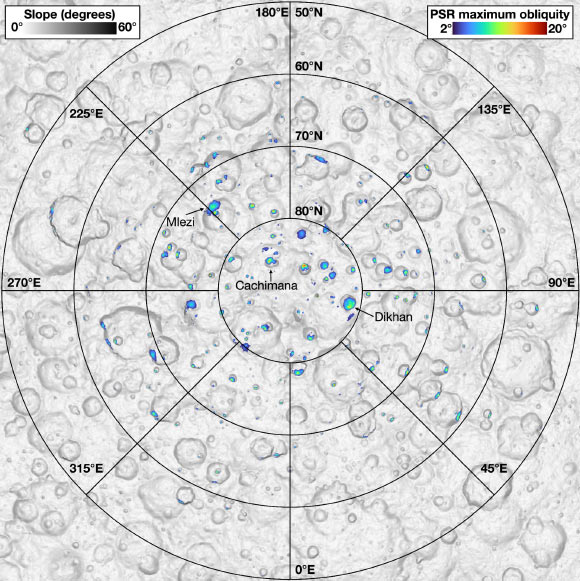The dwarf planet Ceres hosts permanently shadowed areas in its polar regions, and these regions are an interesting analog to Mercury and the Moon. Ceres’ permanently shadowed regions were mapped by NASA’s Dawn spacecraft, and, thanks to scattered sunlight, bright deposits were discovered in a fraction of the permanently shadowed regions. To arrive at a clearer understanding of the nature of cold-trapped ice deposits on Ceres, researchers from the Planetary Science Institute and NASA’s Goddard Space Flight Center constructed improved shape models of permanently shadowed region-hosting craters.
Permanently shadowed regions in the north polar region of Ceres; the color indicates the maximum obliquity at which a location is in shadow through an entire orbit. Image credit: Schorghofer et al., doi: 10.3847/PSJ/ad3639.
“For Ceres, the story started in 2016, when the Dawn spacecraft, which orbited around Ceres at the time, glimpsed into these permanently dark craters and saw bright ice deposits in some of them,” said lead author Dr. Norbert Schorghofer, a researcher at the Planetary Science Institute.
“The discovery back in 2016 posed a riddle: many craters in the polar regions of Ceres remain shadowed all year — which on Ceres lasts 4.6 Earth years — and therefore remain frigidly cold, but only a few of them harbor ice deposits.”
“Soon, another discovery provided a clue why: the rotation axis of Ceres oscillates back and forth every 24,000 years due to tides from the Sun and Jupiter.”
“When the axis tilt is high and the seasons strong, only a few craters remain shadowed all year, and these are the craters that contain bright ice deposits.”
To determine how large shadows were inside of craters thousands of years ago, scientists construct digital elevation maps and then perform ray-tracing calculations with them to theoretically reconstruct the shadows cast on the crater floors.
The results are only as reliable as the digital shape models on which they are based. Keep in mind that the floors of these craters are always in shadow, so it is not easy to measure how deep they are.
NASA’s Dawn spacecraft had a very sensitive camera, which could discern features on the shadowed crater floors.
Stereo images of sunlit regions are often used to construct digital elevation maps of sunlit regions, but making an elevation map of shadowed terrain is a challenge that had rarely been taken on.
As part of their study, the authors developed a new technique to reconstruct heights even in the shadowed portions of a stereo pair of images.
These improved elevation maps can then be used for ray-tracing to predict the extent of cold, permanently shadowed regions.
These more accurate maps yielded a surprising result: when Ceres reaches its maximum axis tilt, which last occurred about 14,000 years ago, no crater on Ceres remains perennially shadowed and any ice in them must have quickly sublimated into space.
“That leaves only one plausible explanation: the ice deposits must have formed more recently than that,” Dr. Schorghofer said.
“The results suggest all of these ice deposits must have accumulated within the last 6,000 years or less.”
“Considering that Ceres is well over 4 billion years old, that is a remarkably young age.”
“Ceres is an ice-rich object, but almost none of this ice is exposed on the surface. The aforementioned polar craters and a few small patches outside the polar regions are the only ice exposures. However, ice is ubiquitous at shallow depths, so even a small dry impactor could vaporize some of that ice.”
“A fragment of an asteroid may have collided with Ceres about 6,000 years ago, which created a temporary water atmosphere.”
“Once a water atmosphere is generated, ice would condense in the cold polar craters, forming the bright deposits that we still see today.”
“Alternatively, the ice deposits could have formed by avalanches of ice-rich material. This ice would then survive in only the cold shadowed craters.”
“Either way, these events were very recent on an astronomical time scale.”
The researchers also looked into the possibility that other types of ices, other than water ice, might be trapped in these unusual craters on Ceres.
On our Moon, portions of polar craters are so cold that even carbon dioxide ice and a few other chemical species could last in them for billions of years.
Ceres is farther from the Sun, so its polar craters could be expected to be even colder than the Moon’s.
The scientists calculated temperatures inside Ceres’ polar craters, something that had never been done before.
The answer was surprising: although these craters are cold enough to retain water ice, they are too warm to retain other common types of ice. Two circumstances contribute to this.
First, the axis tilt of Ceres, currently 4 degrees, is higher than the Moon’s 1.5 degree tilt, so more of the crater rims are sunlit and more light is scattered onto the crater floor.
Second, Ceres simply has no perennially shadowed craters very near the north pole, unlike the Moon, where one crater sits almost exactly on the south pole.
For these reasons, temperatures are not as low on Ceres than they are on parts of the lunar surface.
“Whatever the history of the ice deposits, it resulted from events not much older than human civilization,” Dr. Schorghofer said.
The findings appear in the Planetary Science Journal.
_____
Norbert Schorghofer et al. 2024. History of Ceres’s Cold Traps Based on Refined Shape Models. Planet. Sci. J 5 (99); doi: 10.3847/PSJ/ad3639
>>> Read full article>>>
Copyright for syndicated content belongs to the linked Source : Sci-News.com – https://www.sci.news/space/ceres-cold-traps-12927.html
